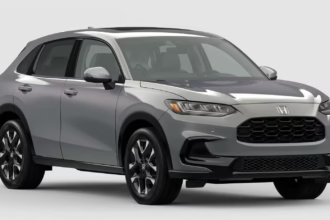Introduction to Driver-Assist Technology
In recent years, the automotive industry has undergone a seismic transformation with the emergence and rapid evolution of driver-assist technology. What once seemed futuristic—cars that could brake automatically, stay in their lane, or park themselves—is now increasingly standard in modern vehicles. Designed to enhance both safety and convenience, driver-assist systems bridge the gap between traditional manual driving and full autonomy.Driver-assist technology refers to systems integrated into vehicles that help drivers make safer, quicker, and smarter decisions. These advanced systems utilize cameras, radar, and AI software to monitor the surroundings. However, they are not designed to replace the driver entirely; instead, they act as an intelligent co-pilot.
As road traffic becomes more congested and accident rates remain a concern globally, automakers are investing heavily in developing smarter, more intuitive driver-assistance features. This article delves into the components, benefits, challenges, and future of driver-assist technology, exploring how it’s reshaping our driving experience.
Adaptive Cruise Control adjusts speed automatically, helping maintain a safe distance from the car ahead. Moreover, it proves extremely useful in stop-and-go traffic conditions. This functionality enhances both safety and comfort.
What is Driver-Assist Technology?
Driver-assist technology, also known as Advanced Driver-Assistance Systems (ADAS), refers to electronic systems in vehicles that use advanced sensors, cameras, radar, and artificial intelligence to help drivers navigate the road safely. These systems do not replace the driver but rather support decision-making, reduce human error, and automate certain driving tasks.
Some of the core functionalities include:
- Adaptive cruise control
- Lane-keeping assist
- Automatic emergency braking
- Blind spot monitoring
- Parking assistance
- Traffic sign recognition
These features are now available in cars across all segments, from budget-friendly compacts to high-end luxury sedans.
Core Components of Driver-Assist Technology
1. Cameras and Sensors
Driver-assist systems rely on 360-degree cameras, ultrasonic sensors, LiDAR, and radar modules to monitor surroundings. These devices collect data in real-time to detect other vehicles, pedestrians, road markings, and obstacles.
2. Central Processing Units (CPUs)
The data from sensors and cameras is processed by powerful CPUs. Using machine learning algorithms, the system interprets road conditions and initiates the appropriate response, such as slowing down or steering slightly.
3. Software Algorithms
These systems use predictive models to forecast potential risks. For example, forward-collision warning systems analyze the speed and distance of vehicles ahead and warn the driver of potential danger.
Popular Driver-Assist Features in Modern Cars
1. Adaptive Cruise Control (ACC)
This feature automatically adjusts the vehicle’s speed to maintain a safe distance from the car ahead. It relieves the driver of the need to constantly brake and accelerate in traffic.
2. Lane Departure Warning (LDW) and Lane Keeping Assist (LKA)
LDW alerts the driver if the car drifts out of its lane without using a turn signal, while LKA gently steers the vehicle back into the lane.
3. Blind Spot Detection
Using side sensors, this feature alerts the driver to vehicles in adjacent lanes that may not be visible in mirrors.
4. Autonomous Emergency Braking (AEB)
If a collision is imminent, the system applies the brakes automatically to prevent or reduce impact.
5. Traffic Sign Recognition
Cameras identify road signs such as speed limits and relay the information to the driver, ensuring compliance with traffic laws.
6. Driver Monitoring Systems
These detect signs of fatigue or distraction by tracking eye movements, posture, and steering behavior. Alerts are triggered if the system deems the driver inattentive.
Benefits of Driver-Assist Technology
1. Improved Road Safety
Driver-assist features significantly reduce the likelihood of accidents caused by human error. A study by the Insurance Institute for Highway Safety (IIHS) found that vehicles with AEB and LDW systems have a lower crash rate.
2. Enhanced Driving Comfort
Long drives and urban commutes become less stressful when the car takes over some responsibilities like speed control, steering, and braking.
3. Lower Insurance Premiums
Cars equipped with advanced driver-assist systems often qualify for lower insurance premiums due to their safety credentials.
4. Better Traffic Flow
With features like adaptive cruise control and traffic jam assist, vehicles maintain optimal speeds, reducing traffic congestion and improving fuel efficiency.
5. Accessibility for Elderly or Disabled Drivers
Some assistive features enable individuals with limited mobility to drive more safely and confidently.
Challenges and Limitations
1. Overreliance by Drivers
There’s a risk that drivers may become too reliant on these systems, assuming the car can handle all situations. This false sense of security can be dangerous.
2. Weather and Environmental Limitations
Fog, heavy rain, and snow can impair camera and sensor accuracy, affecting the performance of driver-assist systems.
3. High Repair and Maintenance Costs
Vehicles with ADAS require specialized parts and technicians, making repairs more expensive than traditional systems.
4. Privacy and Data Concerns
Driver-assist technology collects vast amounts of data that, if not properly secured, could be vulnerable to cyberattacks or privacy breaches.
5. Limited Infrastructure Compatibility
Not all roads are designed with smart features in mind. Poor lane markings or faded signs can confuse ADAS systems, especially in developing countries.
Driver-Assist Technology in Pakistan: Current Status and Adoption
In Pakistan, driver-assist technology is slowly gaining traction, particularly in premium models like Toyota Fortuner, Honda Accord, Hyundai Tucson, and the new Kia Sportage. Brands like MG, Haval, and Changan are introducing affordable models with basic ADAS features such as lane assist and AEB.
However, challenges such as poor road infrastructure, inconsistent traffic behavior, and a lack of consumer awareness hinder large-scale adoption. Additionally, the cost of ADAS-equipped vehicles remains high for the average Pakistani buyer.
Still, the future looks promising. Local assemblers are exploring partnerships to introduce cost-effective driver-assist systems in upcoming models. As safety awareness grows, consumer demand is likely to drive adoption further.
Future Trends in Driver-Assist Technology
1. Vehicle-to-Everything (V2X) Communication
This involves cars communicating with other vehicles, infrastructure, and pedestrians to improve traffic flow and safety.
2. AI-Powered Predictive Systems
Future ADAS will anticipate driver behavior and road risks even more accurately using real-time AI and big data analysis.
3. Full Self-Driving Evolution
Driver-assist is a stepping stone toward full autonomy. Companies like Tesla, Waymo, and Mercedes-Benz are pushing the limits of what is possible with Level 3 and Level 4 automation.
4. Driver-assist technology Affordable Integration
Economies of scale and technological advancement are reducing the cost of ADAS components, allowing mid-tier and even entry-level vehicles to benefit.
5. Driver-assist technology Integration with Smart Cities
Driver-assist systems will eventually sync with smart city infrastructures—traffic signals, emergency services, and digital road mapping—for a seamless, safer driving environment.
Responsibility: Staying Alert Despite Assistance
One of the most important messages manufacturers and regulators continue to stress is: driver-assist is not driver replacement. While the systems can help in various situations, the driver remains responsible for overall vehicle control.
Educational campaigns, user manuals, and onboard reminders are being used to help drivers understand the capabilities and limitations of these systems. The goal is not just to assist but to encourage safer, more attentive driving Lane Departure Warning alerts the driver if the vehicle unintentionally drifts. Meanwhile, Lane Keeping Assist actively helps steer the car back into its lane. Together, these lane-related systems significantly reduce the risk of accidents..
🔧 Original Paragraph (Problematic)
Driver-assist technology refers to systems integrated into vehicles that help drivers make safer, quicker, and smarter decisions while driving. Driver-assist systems utilize cameras, radar, and AI software. Driver-assist features do not replace the driver.
Driver-assist technology : Conclusion
Driver-assist technology marks a pivotal shift in the way we think about road safety, convenience, and the future of mobility. With each new innovation, we move closer to a world where traffic accidents are rare, driving is less stressful, and mobility is more accessible.
While there are still technological, regulatory, and educational hurdles to overcome, the benefits far outweigh the drawbacks. As this technology becomes more refined and affordable, it will likely become a standard feature in all vehicles, just like airbags and ABS once did.
For now, driver-assist systems serve as a co-pilot—a smart, vigilant, and tireless one—helping drivers make better decisions and ultimately saving lives.

More Articale
MG ES5 EV Coming to Pakistan – International Features
GWM Tank 500 PHEV Arriving Pakistan – International Specs & Features
Capital Smart Motors Signs MoU with Geely to Launch NEVs in Pakistan
ask anything









